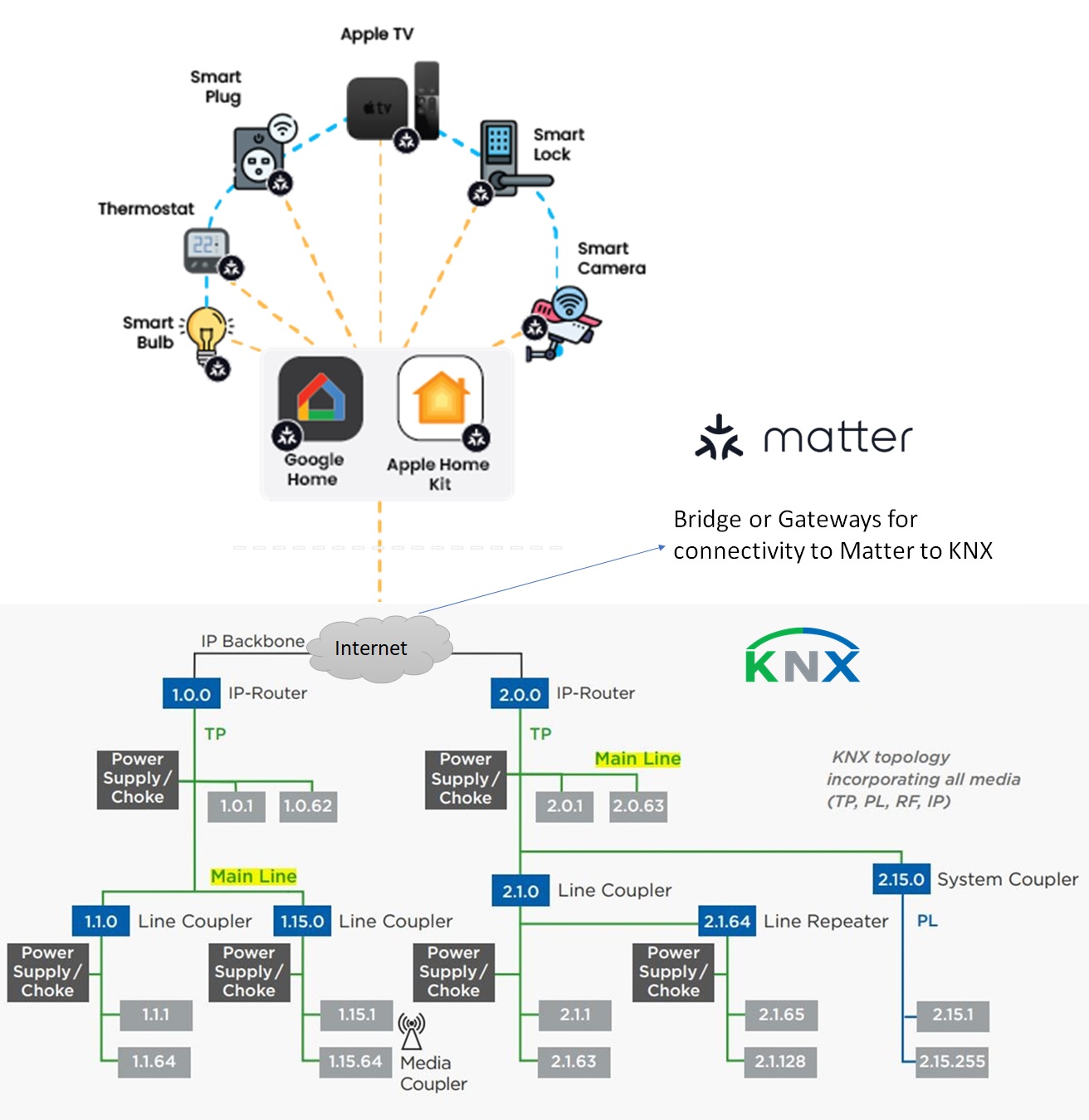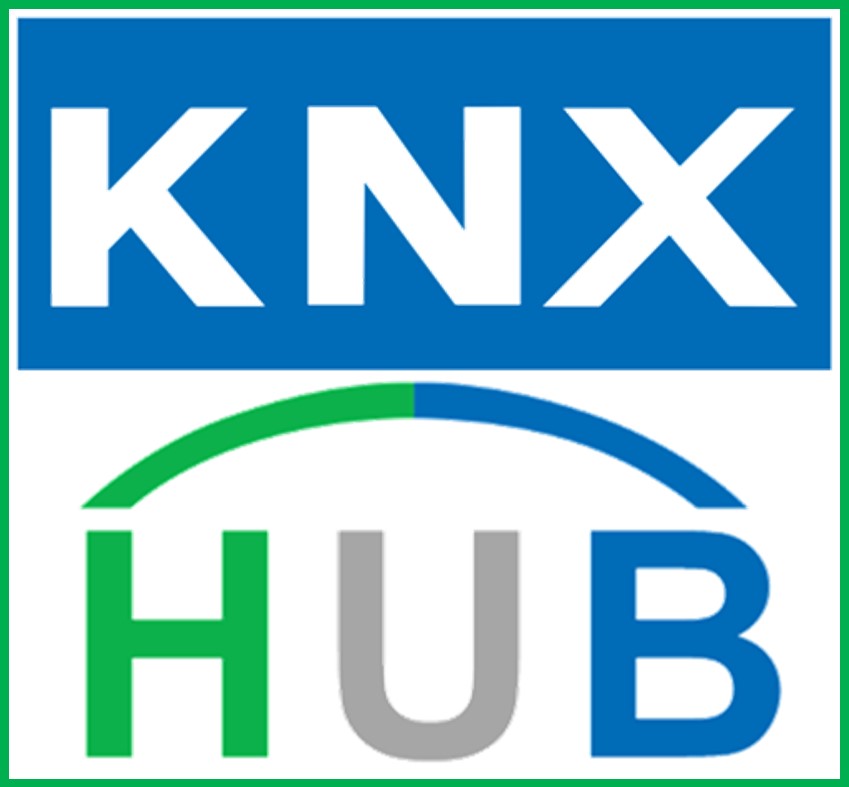
KNX Matter Bridge
KNX Matter Bridge is the future gateway for new era of smart home and building automation. Both KNX And Matter are different smart home technologies, KNX is a worldwide renowned home and building automation protocol which basically evolved from EIB (European installation fieldbus BUS ). On Other side Matter is a protocol of IoT, which can control smart home products over cloud or local network. integration of KNX (Konnex) and Matter represents a significant step towards creating a more seamless and interconnected future. KNX, a well-established standard for home and building control, is now converging with Matter, an open-source connectivity standard backed by major industry players such as Apple, Google, Amazon, and more. This article explores the potential implications and benefits of KNX and Matter integration in shaping the next generation of smart homes.
Matter can communicate over IP network though Wi-Fi, LAN or Thread.

Let’s explain more about each system in the following sections.
What is KNX?
KNX is an established and widely used standardized protocol for home and building automation. It is designed for wired systems and enables various devices within a building, such as lighting, HVAC, security, and more, to communicate and be controlled from a central point or smart phone or tablet or PC. KNX is known for its reliability, flexibility, and interoperability in building automation applications.
KNX standard is evolved from Germany, Europe in 1990. As an open protocol any KNX company can manufacture KNX products which is more versatile and powerful thing about KNX protocol. NX members at the time of Association created was only under 10. Now days there are more than 550+ KNX Manufacturer are all over the world making more then 21000+ smart home products.
Features of KNX
Interoperability: KNX is an open standard, allowing devices from different manufacturers to seamlessly communicate and operate together within the same ecosystem. This fosters interoperability and flexibility in choosing devices for a KNX installation.
Universal Network Architecture: KNX supports a universal network architecture that accommodates various types of devices and systems. It allows for a wide range of applications, from simple residential setups to complex commercial buildings.
Flexible Physical Media: KNX operates over different physical media, including twisted-pair wiring (KNX TP), radio frequency (KNX RF), and powerline communication (KNX PL). This flexibility in physical media enables installations in diverse building structures.
Scalability: KNX installations can easily scale to meet the requirements of different-sized buildings. Whether it’s a small residence or a large commercial complex, KNX offers scalability to support the desired level of automation.
Security: KNX incorporates security features to protect communication and data integrity. Encryption and authentication mechanisms contribute to securing the KNX network, making it suitable for applications with privacy and security requirements.

What is Matter?
“Matter” refers to a connectivity standard for smart home devices, Its a part of IoT. Initially known as Project Connected Home over IP (Project CHIP), Matter is a collaborative effort among major technology companies to establish a unified and open standard for smart home devices and ensure their compatibility.
Matter is developed through collaboration among industry leaders including Apple, Google, Amazon, the Connectivity Standards Alliance (CSA, formerly known as the Zigbee Alliance), and others. The goal is to create a standard that works seamlessly across various ecosystems.


Features of Matter
Open Source: Matter is an open-source project, allowing developers to contribute to its development and ensuring transparency in its specifications. This openness is intended to encourage widespread adoption and innovation.
Cross-Platform Compatibility: One of the primary objectives of Matter is to provide cross-platform compatibility for smart home devices. It aims to allow devices from different manufacturers and ecosystems to work together seamlessly, reducing fragmentation in the smart home space.
IP-Based Protocol: Matter is built on an IP (Internet Protocol) foundation, facilitating secure and reliable communication between devices over standard networking technologies.
Supported Connectivity Technologies: Matter is designed to work over various connectivity technologies, including Ethernet, Wi-Fi, and Thread. Thread is a low-power wireless mesh networking protocol that is also supported by Matter.
Security and Privacy: Matter places a strong emphasis on security and privacy. It includes features such as end-to-end encryption to protect user data and ensure secure communication between devices.
Application Support: Matter supports a wide range of smart home applications, including lighting, HVAC, security, and more. This versatility makes it applicable for various devices and scenarios within a smart home environment.
Specially Matter devices can work on local network without any internet connectivity, which makes it easy to use.
Matter devices are more secure than current smart home devices, thanks to features like encryption and authentication.
Matter designed simple in such a way that both for developers and for end users. Many smart home players that have already committed to develop and support on Matter like: Apple, Google, Amazon, Samsung, IKEA, ZigBee Alliance, and more.
How Matter and KNX systems work together?

KNX Matter Bridge – KNX and smart home apps via Matter into a single system is simple and seamless. We’ll be using Apple Home as an example, but you can also use Google Home, Amazon Alexa, or Samsung SmartThings.
KNX – KNX serves as a reliable backbone of your system. It controls your lights, blinds, heating, wall switches, sensors such as motion, temperature, brightness sensors, and similar mission-critical devices. KNX will make them as reliable as a classical electrical installation. A rule of thumb is to use KNX to control all devices that must work at all times and should last for decades.
Apple Home (or any other Matter-supported mobile app) – Use it as a control center of all your KNX and non-KNX devices. With this, you get a modern way to control your home and create different automation combining every device in your home. Within Apple Home, you won’t even notice which devices come from KNX and which do not, it is that seamless.
The Potential of KNX and Matter Integration:
- Enhanced Interoperability:
- KNX Matter Bridge could lead to enhanced interoperability among a wider range of devices. This collaboration allows homeowners to seamlessly connect KNX-certified devices with Matter-compatible smart home products, creating a more versatile and integrated environment.
- Simplified Ecosystems:
- KNX Matter Bridges the smart home ecosystem becomes more accessible and user-friendly. Homeowners and integrators may experience simplified installation processes and increased flexibility when selecting devices, regardless of the manufacturer, leading to a more harmonious and cohesive user experience.
- Scalability and Future-Proofing:
- The integration holds the potential for scalability, allowing homeowners to easily expand and adapt their smart home systems. With KNX and Matter working in unison, users can future-proof their investments by integrating new devices seamlessly as they become available, ensuring long-term compatibility and relevance.
KNX Matter Bridge Challenges and Considerations:
- Standardization and Certification:
- Achieving a successful integration requires careful consideration of standardization and certification processes. Ensuring that both KNX and Matter devices adhere to agreed-upon standards is crucial for a smooth and reliable integration.
- Security Measures:
- As with any integration of smart home technologies, security remains a paramount concern. Developers and industry stakeholders must collaborate to implement robust security measures, safeguarding user data and privacy in the integrated KNX and Matter ecosystem.
Thanks.!!

